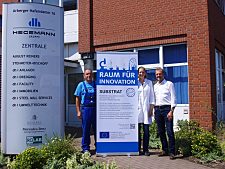Upcycling of waste material into topsoil-quality substrate
A dh|UMWELTTECHNIK research project

The new research project entitled Production of topsoil-equivalent soil substrate from aquatic sediments using innovative process technology by DETLEF HEGEMANN Umwelttechnik GmbH was launched in April 2018. The project aims to develop new ways to make use of aquatic sediments and other municipal waste.
The systematic analysis of various material blends and technical processes is intended to permit the upcycling of the waste material into topsoil-quality substrate with innovative functionalities.
Even though aquatic sediments are rarely contaminated nowadays, they are still stored in special landfill sites. However, the European Waste Framework Directive stipulates a recycling rate for non-contaminated sediment of 70% by 2020. Also, the dumping of the sediment entails significant costs which could be saved if the waste material is recycled. It is therefore very important to develop new recycling possibilities for aquatic sediment.
The topsoil-quality substrate is to be used as a construction material for topsoil layers which roots can grow through and to provide an alternative to natural, finite topsoil. Large-scale construction projects in particular have to cope with non-homogeneous topsoil and general shortages of materials, since topsoil is protected by law in Germany and may not be mined.

The main challenges facing the project are the varying characteristics of the natural feedstock material and the homogeneous processing of the material, which can possess very different textures and properties.
The project is of great benefit to the regional economy since the use of soil substrate mainly makes economic sense at a regional level and all of the stakeholders in the value chain are based in the region. Further to this, however, supraregional application scenarios are also feasible.
The project is financed with funding from the European Union and the State of Bremen – by the Senator for Climate Change Mitigation, Environment, Mobility, Urban Development and Housing Construction under the Applied Environmental Research funding programme.

This project focus on innovation an is supported by our heroine Felicia